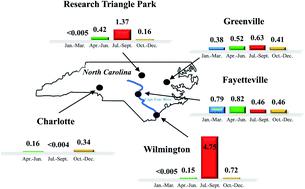当前位置:
X-MOL 学术
›
Environ. Sci.: Processes Impacts
›
论文详情
Our official English website, www.x-mol.net, welcomes your
feedback! (Note: you will need to create a separate account there.)
PFOS dominates PFAS composition in ambient fine particulate matter (PM2.5) collected across North Carolina nearly 20 years after the end of its US production
Environmental Science: Processes & Impacts ( IF 4.3 ) Pub Date : 2021-3-7 , DOI: 10.1039/d0em00497a J. Zhou 1, 2, 3, 4, 5 , K. Baumann 1, 2, 3, 4, 5 , R. N. Mead 5, 6, 7, 8, 9 , S. A. Skrabal 5, 6, 7, 8, 9 , R. J. Kieber 5, 6, 7, 8, 9 , G. B. Avery 5, 6, 7, 8, 9 , M. Shimizu 5, 6, 7, 8, 9 , J. C. DeWitt 5, 10, 11, 12, 13 , M. Sun 5, 14, 15, 16 , S. A. Vance 5, 10, 11, 12, 13 , W. Bodnar 1, 2, 3, 4, 5 , Z. Zhang 1, 2, 3, 4, 5 , L. B. Collins 5, 17, 18, 19 , J. D. Surratt 1, 2, 3, 4, 5 , B. J. Turpin 1, 2, 3, 4, 5
Environmental Science: Processes & Impacts ( IF 4.3 ) Pub Date : 2021-3-7 , DOI: 10.1039/d0em00497a J. Zhou 1, 2, 3, 4, 5 , K. Baumann 1, 2, 3, 4, 5 , R. N. Mead 5, 6, 7, 8, 9 , S. A. Skrabal 5, 6, 7, 8, 9 , R. J. Kieber 5, 6, 7, 8, 9 , G. B. Avery 5, 6, 7, 8, 9 , M. Shimizu 5, 6, 7, 8, 9 , J. C. DeWitt 5, 10, 11, 12, 13 , M. Sun 5, 14, 15, 16 , S. A. Vance 5, 10, 11, 12, 13 , W. Bodnar 1, 2, 3, 4, 5 , Z. Zhang 1, 2, 3, 4, 5 , L. B. Collins 5, 17, 18, 19 , J. D. Surratt 1, 2, 3, 4, 5 , B. J. Turpin 1, 2, 3, 4, 5
Affiliation

|
Contamination of drinking water by per- and polyfluoroalkyl substances (PFASs) emitted from manufacturing plants, fire-fighting foams, and urban waste streams has received considerable attention due to concerns over toxicity and environmental persistence; however, PFASs in ambient air remain poorly understood, especially in the United States (US). We measured PFAS concentrations in ambient fine particulate matter (PM2.5) at 5 locations across North Carolina over a 1 year period in 2019. Thirty-four PFASs, including perfluoroalkyl carboxylic, perfluoroalkane sulfonic, perfluoroalkyl ether carboxylic and sulfonic acids were analyzed by UHPLC/ESI-MS/MS. Quarterly averaged concentrations ranged from <0.004–14.1 pg m−3. Perfluorooctanoic acid (PFOA) and perfluorooctane sulfonic acid (PFOS) ranged from <0.18 to 14.1 pg m−3, comparable to previous PM2.5 measurements from Canada and Europe (<0.02–3.5 pg m−3). Concentrations above 1 pg m−3 were observed in July–September at Charlotte (14.1 pg m−3, PFOA), Wilmington (4.75 pg m−3, PFOS), and Research Triangle Park (1.37 pg m−3, PFOS). Notably, PM2.5 has a short atmospheric lifetime (<2 weeks), and thus, the presence of PFOS in these samples raises questions about their sources, since PFOS production was phased out in the US ∼20 years ago. This is the first US study to provide insights into ambient PFAS concentrations in PM2.5.
中文翻译:

在美国生产结束近20年后,全氟辛烷磺酸在全北卡罗来纳州收集的环境细颗粒物(PM2.5)中占PFAS成分的主导地位
由于担心毒性和环境持久性,从制造厂,灭火泡沫和城市废物流中排放的全氟和多氟烷基物质(PFAS)对饮用水的污染受到了广泛关注;然而,人们对环境空气中的PFAS仍然知之甚少,尤其是在美国。我们在2019年的1年时间内测量了北卡罗莱纳州5个地点的环境细颗粒物(PM 2.5)中的PFAS浓度。通过UHPLC /分析了34种PFAS,包括全氟烷基羧酸,全氟烷磺酸,全氟烷基醚羧酸和磺酸。 ESI-MS / MS。季度平均浓度范围从<0.004-14.1 pg m -3。全氟辛酸(PFOA)和全氟辛烷磺酸(PFOS)的范围从<0.18到14.1 pg m -3,与加拿大和欧洲以前的PM 2.5测量值(<0.02-3.5 pg m -3)相当。在7月至9月的夏洛特(14.1 pg m -3,全氟辛酸),威尔明顿(4.75 pg m -3,全氟辛烷磺酸)和三角研究园(1.37 pg m -3,全氟辛烷磺酸)观察到1 pg m -3以上的浓度。值得注意的是,PM 2.5由于全氟辛烷磺酸的大气寿命很短(<2周),因此,这些样品中存在全氟辛烷磺酸引起了人们对其来源的质疑,因为全氟辛烷磺酸的生产已在20年前在美国逐步淘汰。这是美国第一项提供有关PM 2.5中环境PFAS浓度的见解的研究。
更新日期:2021-03-16
中文翻译:

在美国生产结束近20年后,全氟辛烷磺酸在全北卡罗来纳州收集的环境细颗粒物(PM2.5)中占PFAS成分的主导地位
由于担心毒性和环境持久性,从制造厂,灭火泡沫和城市废物流中排放的全氟和多氟烷基物质(PFAS)对饮用水的污染受到了广泛关注;然而,人们对环境空气中的PFAS仍然知之甚少,尤其是在美国。我们在2019年的1年时间内测量了北卡罗莱纳州5个地点的环境细颗粒物(PM 2.5)中的PFAS浓度。通过UHPLC /分析了34种PFAS,包括全氟烷基羧酸,全氟烷磺酸,全氟烷基醚羧酸和磺酸。 ESI-MS / MS。季度平均浓度范围从<0.004-14.1 pg m -3。全氟辛酸(PFOA)和全氟辛烷磺酸(PFOS)的范围从<0.18到14.1 pg m -3,与加拿大和欧洲以前的PM 2.5测量值(<0.02-3.5 pg m -3)相当。在7月至9月的夏洛特(14.1 pg m -3,全氟辛酸),威尔明顿(4.75 pg m -3,全氟辛烷磺酸)和三角研究园(1.37 pg m -3,全氟辛烷磺酸)观察到1 pg m -3以上的浓度。值得注意的是,PM 2.5由于全氟辛烷磺酸的大气寿命很短(<2周),因此,这些样品中存在全氟辛烷磺酸引起了人们对其来源的质疑,因为全氟辛烷磺酸的生产已在20年前在美国逐步淘汰。这是美国第一项提供有关PM 2.5中环境PFAS浓度的见解的研究。









































 京公网安备 11010802027423号
京公网安备 11010802027423号